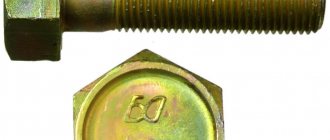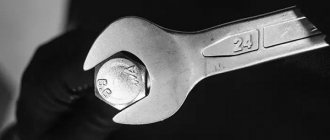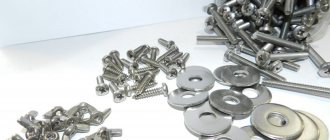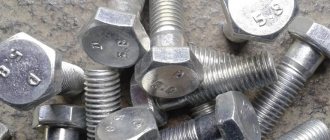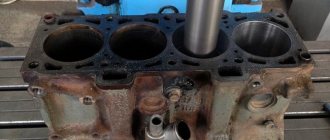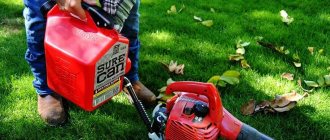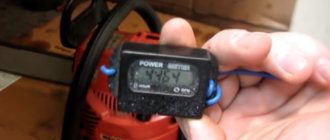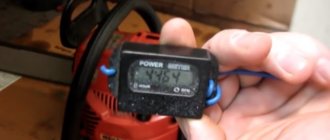Repairing a car is far from the easiest process, and it doesn’t matter what brand the car is or what year it is made. All cars are subjected to serious loads every day, which means breakdowns are inevitable. The average motorist can easily fix most of these faults in a garage, working slowly and carefully. If you are careless when it comes to car repairs, you can often complicate the situation.
It so happens that during repair work, when tightening or unscrewing bolts and studs, the threads break off. This is very unpleasant, especially if there is no knowledge of how to unscrew a broken pin. This situation confuses any repair. Let's try to figure out how to get out of this unpleasant situation.
However, the fasteners do not unscrew and break not only due to moisture, but also due to high temperatures. For example, the exhaust manifold can be heated up to 400 degrees. As a result of exposure to high temperatures over a long period of time, the stud corrodes.
How do studs break?
These fasteners can break in different ways. The most unpleasant situation is when they are cut off literally flush. Then the master has to think about how to unscrew the broken pin, because in this case it is impossible to do without the use of special tools and technologies.
It is much better if the part breaks already at the exit from the thread, when a small part of its “body” will be visible and remain on the surface. In this case, if the bolt has already been torn off, it will turn out and can be manipulated with pliers, screwdrivers and welding.
Effective ways to deal with broken bolts and studs
Professional locksmiths know several effective methods on how to unscrew a broken pin. Before you start this task, you need to prepare. By these works we mean cleaning the surface from dirt and grease. It is recommended to pre-treat the threaded connection with WD-40 or ordinary machine oil. You can also ease the situation by hitting the piece of wood with a hammer several times. Often the problem is solved by heating - a pin or bolt, provided that it looks out of the hole, is heated with a soldering iron. Then it can be removed relatively easily.
Flat head screwdriver and hammer
An accessible method, effective if the fracture occurs above the thread and the surface has an uneven edge. Then for extraction you will need a simple set of tools, which can be found in any garage.
We carefully examine the cleaned surface and find the largest protrusion on the fracture area. We place a flat-head screwdriver at an angle, pressing into the selected location. For more reliable support, you can use a core, with which the unevenness deepens. After this, using gentle blows, we carefully try to turn the thread. If you can’t do this right away, you need to gradually increase the strength.
However, you should be extremely careful with this method, since, firstly, the surface must be accessible enough for the hammer to work. And secondly, you need to carefully calculate the force of the impact to prevent damage to adjacent parts.
How to unscrew a stud if it breaks above the thread
If in the process you managed to break the thread even a little, that is, if the fastening element began to turn out, you can try using pliers or pliers. A good and powerful adjustable wrench will also help in this difficult task. In the second option, you may need a hacksaw or a grinder. Sometimes a chisel will do just fine - the main thing is not to use excessive force. How to unscrew a broken wheel stud this way? Make a transverse hole for a screwdriver and unscrew the pin with this tool.
If a screwdriver does not help, then you can use a welding machine. This operation is quite easy. Prepare a bolt whose head approximately corresponds to the diameter of the stud. Next, the bolt is welded to the fragment protruding from the hole. Then, using a key and without extra effort, they try to unscrew the unfortunate pin. Experienced auto mechanics say that there are special adhesives with aggressive action that can be used as cold welding. But they are not always effective.
Method 6 - drill, use a hexagon and a lever
Suitable for VAZ 2108, 2199 and other cars with cylinder head bolts having internal edges. The essence of the method is to drill a hole in the bolt and unscrew it with a wrench. The hole is drilled so that the bolt loses its rigidity.
Take a drill with a power of at least 750 W (the more the better) and a drill with a diameter of 10 mm. The depth of the hole should be greater than the distance from the upper edge of the bolt to the washer, that is, go below the latter.
Next, we set the bolt using a hammer and a powerful spacer, which is inserted into the hole. The essence of the method is described above.
Next, we drive a four- or hexagon or a 25 Torx wrench into the hole.
Using a lever tube, unscrew the bolt. This method is described in more detail in the video.
Left-hand thread in stud
The second method is more complicated. It is used when it is impossible to unscrew a broken pin using any of the available methods. In this case, the measures taken will be even more drastic. This method will require an electric drill, a tap and a lot of time. First of all, a hole is drilled in the stud - right in the center. Then carefully cut the thread in the hole with a tap.
Let us note an important point: before unscrewing the broken pin from the head, make sure that the thread is “left-handed”. When a new bolt with the same thread is screwed into the newly cut part, the moment it reaches the end, the broken pin will begin to turn out.
Drilling
And finally, the third and most radical way. It is used to remove broken bolts and studs from the hole. This is drilling. The method is very difficult. It is much more complex than all of the above and is the most dangerous. There is a risk of damaging the threads in the bore of the engine block or cylinder head. The drill should be held securely, as if it is a cylinder block, there is a serious risk of damaging an expensive part. The stud is often made of harder grades of steel, and the head is made of aluminum. The commutator body is cast iron, so it is also softer than a steel stud. The drill will definitely move away from the hard stud and towards the softer metal. This happens especially often if the work is carried out in a confined space and the drill is installed at a slight angle. The principle of drilling is as follows: you need to make a hole strictly in the center of the stud with a thin drill, having previously cored it, then install a thicker one in the drill and repeat the entire procedure.
The main thing here is to drill strictly in the center. When practically nothing remains of the stud body, the wall will become thin. It can be broken. You should very carefully break off the remaining pins using pre-sharpened wire or tweezers. It must be remembered that any action is carried out as slowly and carefully as possible. If you act rashly, you will need to think not about how to unscrew the broken block stud, but also about how to restore the cylinder head itself. And these are significant costs.
Method 2 - drilling and unscrewing with a chisel
Suitable for cylinder head bolts with outer edges that have been torn off.
- Using a drill and a 10 mm drill bit, drill a hole in the center of the bolt, the depth of which should extend beyond the height of the edges of the head.
- Place the chisel at a right angle and, with strong blows, punch an edge in the bolt 2-3 mm deep.
- Place the chisel at a 45-degree angle to the surface of the head and begin to unscrew it with strong counterclockwise blows. Usually you have to beat for 4 to 5 minutes for the process to start.
We use a conductor
You can greatly simplify the operation of drilling out broken studs. This is relevant for those who often repair engines. A simple conductor will help the master. The dimensions of the part are taken from real engines. On the conductor, which is a metal plate, the same holes are drilled in the same places as on the head, as well as on the commutator. Holes for bushings are also made in the jig. They will keep the part from moving on the block.
With the help of such devices, you can greatly facilitate the task and figure out how to unscrew a broken pin from the exhaust manifold by drilling without damaging the manifold itself.
Technology for working with internal and external threads
Restoring threads using the “Cold Welding” composition involves the use of a two-component mixture. Each component is placed in a small tube. The stages of work can be represented as the following steps:
- Open the package, take out everything that is included in the composition;
- Degrease the surfaces prepared for work (first tube);
- Eliminate the possibility of plaque appearing on parts;
- The thread is cleaned with an anti-adhesive compound (second tube);
- Mixing mixtures from two tubes on a specially prepared non-metal surface. You will need a spatula for mixing;
- The resulting mass is placed on the thread, the part is screwed in to give the teeth the desired shape both inside and outside;
- Leave the part to dry;
- Maintain the time specified in the instructions.
To obtain the desired result, the ambient temperature and air humidity are checked.
Then the part is unscrewed and the quality of the work done is checked.
Extractors
An extractor is a special device that allows you to remove the remains of faulty fasteners or unscrew a broken pin. The device is very simple and at the same time ingenious. In order to remove a stuck or broken part, you need to somehow hook it and then unscrew it. And all this is done very simply. You need to drill a hole in the center of the stud, wedge some tool in the shape of a cone or cylinder into it, then use this tool to remove the bolt. This is the extractor. These devices make it much easier to resolve issues such as unscrewing a broken pin from a manifold or from any other places.
There are several types of extractors:
Now these devices can be purchased in sets, but they are also available for sale individually. Experts recommend using these tools. They make solving difficult situations such as broken bolts much easier.
How to paint over a paint defect on a car with a pencil
By following the instructions below, you can get great results!
- Preparation of the defect area - removing contamination, cleaning the coating from residues of polishes, wax, silicone, degreasing and drying. To remove silicone, it is best to use specialized automotive cosmetics.
- Shake the pencil.
- Place it against the defect area and apply several pressures to fill the rod with the corrective compound.
- Fill the damaged area with gel, smoothly and without stopping, rubbing over the scratch.
- Close the pencil. It is better to wrap the cap with additional electrical tape to extend the service life of the working rod.
- Allow the repair area of the body element to dry for 48 hours.
- If the scratch is still visible after the first painting with a felt-tip pen, you can repeat the procedure for treating the damaged area after two days.
Before screwing in the stud...
So that you don’t have to think about how to unscrew a broken pin, before getting to work, it is recommended to lubricate the part with graphite, or better yet, copper grease. It is better to let the element unscrew together with the nut than to break it. And finally, it is also better to treat the nut threads with graphite lubricant. In the future, this will prevent the part from breaking or breaking.
A situation where a bolt breaks during tightening and the broken piece remains in the part is not uncommon. But not many people know that there are quite a few effective ways to drill out a broken bolt.
A situation where a bolt breaks during tightening and the broken piece remains in the part is not uncommon. But not many people know that there are quite a few effective ways to drill out a broken bolt. The main thing is not to panic, but to carefully read this information material to the end.
The bolt broke off flush with the surface of the part or deeper
Difference between bolt and screw
According to experts, such a breakdown is the most difficult. The problem is that it is not always possible to determine the circumference of a broken piece of hardware. Therefore, before you start unscrewing the bolt, you need to clean the place where it is located. This is the only way to determine where the edge of the hardware is and not damage the thread of the part when unscrewing it.
Core is a tool that should be in any workshop or garage PHOTO: fine-tools.com
When the boundaries are determined, you need to mark the center of the broken bolt and, using a special tool (punch), knock out the recess. This is necessary in order to start drilling. Otherwise, the drill will “float” and it will not be possible to drill exactly in the center. The same actions are performed if the bolt breaks off deeper than the upper level of the part.
In theory, the drill should go along the bolt exactly in the center of the PHOTO. yandex.ua
Next, you need to drill a hole exactly in the center, with a diameter smaller than that of the hardware. It should go as smoothly as possible along the axis of the bolt. When this work is completed, you can proceed directly to twisting. To do this, use a tap with a reverse thread, which is screwed into the drilled hole counterclockwise until it stops, after which rotation continues in the same direction. The remaining bolt should come out.
Taps can have right-handed or left-handed threads PHOTO: vseinstrumenti.ru
Using an extractor to deal with broken bolts
If you cannot remove the hardware using a tap, you will need a more powerful tool. This can be a special device called an extractor. It looks like a wrench attachment with a right or left taper thread. The extractor is screwed into the hole until it stops, after which the bolt fragment is unscrewed using a socket with an amplifier. It is almost impossible to break such a device, which means that efforts can be made without fear.
Extractors do an excellent job of turning out broken bolts or studs PHOTO: afmforum.ru
The most typical failure situations
A bolt can break in different ways. The easiest case is when it breaks flush with the part. In this case, there will be no special problems in how to drill the bolt. But, nevertheless, it will be necessary to carry out some preparatory measures that will allow you to extract the remaining part without much difficulty. And they are as follows:
- The most important thing is to prepare yourself for the fact that you can only drill out a broken bolt without damaging the thread if you apply maximum patience and calm. Haste in this case is the main enemy
- First of all, you need to use a tool to quickly unscrew rusty bolted joints. There are a great many of them in the markets. But the overwhelming majority of such funds are absolutely useless. A self-respecting car enthusiast and mechanic should always have in stock a penetrating agent for loosening nuts and bolts, which contains substances that have the ability to penetrate any joint. Recommendations for choosing can be obtained from any well-known car service center. The most effective lubricants are those based on molybdenum disulfide and graphite.
- Next, you can try one of the simplest options on how to drill out a broken bolt without any problems. To do this, you need to use a thin drill and a low-speed drill to drill a slot for a screwdriver.
- You can purchase a gas torch for loosening bolts at any hardware store. If there is such a burner, then with its help it is necessary to slightly warm up the part itself in such a way that the remaining piece does not heat up. In this case, there should be a fire extinguisher nearby.
- Then try using a screwdriver with a wrench to slowly loosen the rest of the bolt. If the bolted connection is not old, then the piece should come off.
Method 3 - welding on the nut or head
Of course, not everyone is good at welding, but you can ask a friend. The essence of the method is to weld a nut onto the problem bolt and then unscrew it.
But, in most cases, this nut also breaks off, so many experts recommend welding a head instead, preferably an already broken one, so that it won’t be so bad.
The advantages of this method:
- The head is higher and you can insert a key with a large lever into it;
- It is more convenient to scald, the scalding area will be larger, which means the head will hold tighter.
The ideal option is to use a semi-automatic device; for a conventional inverter, a 2 mm electrode is used.
After welding, wait until the metal cools down. Then insert a wrench with a large lever into the head and begin to unscrew the bolt.
How to drill out a high strength bolt?
The sequence of actions is the same until the thread is cut in the drilled hole. In this case, before drilling the hardened bolt, it is necessary to make the following part: a bolt with a wrench head is machined from carbon steel. The end of the bolt is given a tetrahedral conical shape using a forging hammer.
Next, the bolt is driven into the drilled hole to the full depth where it should jam. Using a spanner wrench, loosen and gradually unscrew the broken piece of the bolt.
But how to drill out a broken bolt if no other method helps? In this case, the only drastic way is to completely drill out the rest of the part. This is the most difficult and responsible way to drill a bolt without damaging the threads in the mechanism parts.
To begin with, a hole is drilled in the fragment using a thin drill. Then thicker. And so on until most of the remaining piece is drilled out. This is one of the most effective ways to drill a bolt from a car hub.
Method 1 - bolt shrinkage
Suitable for VAZ 2107 (other classic models), as well as cars where the cylinder head is secured with bolts to the outer edges. On models of the 2108 series and higher, this method is also acceptable, but at a certain stage of the work there you will have to resort to drilling.
Our goal is to seat the bolt using strong blows. As a result of vibrations and other complex physical processes, it will weaken.
But before you hit, try setting the head to 11 on the bolt with the licked edges and try to unscrew it that way.
If it doesn’t help, then take two hammers. We place the first one with the flat side on the problem bolt, and with the second hammer we hit the first one hard.
Next, the head is pressed onto the flattened head and the bolt is unscrewed using a large lever.
If the first attempt fails, then the second and third will definitely be successful. Typically this can take up to 20 minutes.
It is advisable that all other cylinder head bolts are tightened in order to press the head as much as possible. The method is described in more detail in the video.
Other “folk” methods
Craftsmen in various videos offer other more radical ways of how to properly drill out a broken bolt. One of the popular methods is when, using an electric welding machine, they weld a piece of metal in the form of a handle to a fragment and try to unscrew it.
Sometimes this works, but this usually damages the threads and fades the paint on the mechanism. And if the handle breaks off, then drilling a hole will be very difficult. Therefore, if you don’t have a basic idea of how to drill a bolt without damaging the thread, it’s better not to try it, as the consequences can be very sad.
It is generally accepted that
...a self-tapping screw is the same screw, but only in a modern version. In the old days, almost all fastenings were made using screws. To do this, you had to drill a hole and then screw a screw into it. Unlike screw fastening, self-tapping screws do not require additional preparation that will involve drilling a hole. They can be screwed using a screwdriver or even a regular screwdriver into any suitable surface.
According to external data, the differences between these two fastening elements are small. Screws in the upper part under the head have a smooth part of the shaft that does not have threads, but self-tapping screws have threads throughout the entire shaft up to the head
Ignorant people may not even immediately pay attention to such features, and will not even find the differences. In construction markets, small self-tapping screws are sold by weight, but large samples are sold individually. https://www.youtube.com/embed/qfVy_fC-qqg
How to drill out a broken bolt from an aluminum block?
It happens quite often that a small diameter bolt in an aluminum car engine block breaks. It is not easy to drill out such a remaining bolt. The Internet offers a lot of options on how to drill out a broken M6 bolt from aluminum without much difficulty.
In fact, the most reliable method is classic drilling followed by tapping. In this case, all the preparatory operations discussed above must be carried out very carefully.
All sorts of Chinese extractors are advertised, but they very often break inside the hole, which greatly aggravates the situation. In addition, this tool, with its conical shape, creates additional friction between the walls of the bolt and the block, which makes extraction difficult.
Conclusion
In any case, a bolt breaking in the most inopportune place is a rather unpleasant and unusual situation. It is best to have an experienced specialist remove the remaining part. Otherwise, you can completely ruin an expensive part, which will lead to unexpected expenses.
For clarity, how to drill a bolt without damaging the thread, you can watch the video here:
Threaded connections are the most widely used among detachable connections. They come in a variety of sizes; screws, bolts and nuts are found in both a smartphone and a nuclear reactor. Each connection must be tightened with proper torque. Sometimes the threads become clogged with dirt or become a victim of corrosion. When you try to unscrew the connection, the maximum force is exceeded and the thread breaks. It even reaches the point of destruction of the fastener body. In order to remove a damaged pin from the body, various techniques are used.
Features and advantages of cylinder head studs
In any engine, the cylinder head (cylinder head) is attached to the block itself with studs. They are screwed into the block in such a way as to ensure the best and uniform pressing of the cylinder head to the block. A high-quality compressed gasket prevents the leakage of oil and antifreeze and the penetration of gases from the cylinder into the engine crankcase. Fasteners are made from high quality steel. However, over time, the threads on them may corrode and become clogged with various contaminants. Due to exposure to high temperatures, these contaminants are sintered, and the nut “sticks.” When you try to unscrew such a stuck nut and exceed the maximum force, either the thread breaks off or the fastener breaks off. In both cases, it is necessary to replace the broken part.
Replacing the stud
Experienced craftsmen recommend unscrewing and changing all the studs at the same time. Parts from the same batch have similar physical and mechanical characteristics, will bear loads evenly and will last much longer.
Before unscrewing, thoroughly moisten the thread with WD 40 or kerosene. In extreme cases, brake fluid will do. If you don’t have a special puller at hand, you can unscrew it with a gas wrench. You need to pull smoothly, without jerking. If you can’t unscrew it right away, you should apply WD 40 again and wait 5-10 minutes.
After all connections have been unscrewed, they should be replaced with a new set. The threads can be lubricated with graphite lubricant - this will help you easily unscrew the parts if necessary. Next, you should install the cylinder head in place and begin tightening the nuts according to the diagram from the user manual.
- First, all nuts are tightened to light resistance.
- Using a wrench and a dynamometer, achieve the specified tightening force value.
- In the sequence described in the manual, all nuts are finally tightened.
The nuts can also be lubricated with graphite grease.
Method one. We take out a broken hairpin in 5 minutes
This method is good in the case when the stud is not pinched during installation, is screwed into the thread, and the crease occurred precisely due to the thermal expansion of the metal while unscrewing the exhaust manifold nut.
If the pin is broken, but some part of it remains above the manifold mating plane, it will be much easier to unscrew it. If the threaded part breaks off, and the body of the stud turns out to be deeper than the contact plane of the collector, you will have to tinker. And the first method is the simplest, and this is where you need to start trying to unscrew the remaining studs.
We will need a drill with a diameter of 3.2-3.5 mm (if the diameter of the stud is 6 mm), a drill with adjustable speed and a sharpened center punch. Our task is to save the threads in the head, so at low speeds we drill a hole in the stud no deeper than 5-7 mm , having first drilled the stud well.
Now take a Torx T20 bit
and carefully, with light blows of a hammer, seat it in the hole made in the stud.
This forces the carbide bit into the softer metal of the stud.
Then we smoothly turn the bit counterclockwise with a crank, trying not to tear off the newly made indentations.
As a rule, such attempts end successfully and the stud fragment comes out.
It is for these reasons that experts recommend changing studs, if not every time you replace the head gasket , then every other time.
An old stud already has metal fatigue and is prone to stripping threads and breaking.
How to unscrew the remaining fragment
If the pin does break off, don’t despair. To unscrew the broken part, several techniques are used. Some require the use of industrial equipment, while for others, simple equipment available to a home craftsman is sufficient.
How to unscrew a broken hairpin
If a fragment remains sticking out, then use one of the following techniques:
- Put on a nut with a slightly larger diameter and weld it. Next, you can use a key to unscrew the broken pin.
- Weld a transverse rod (reinforcement) 30-40 cm long. Using it as a wrench, you can unscrew the fragment.
- Use a file to sharpen the top to a square. Now the fragment can be unscrewed with a tap wrench.
Unscrewing a broken pin
If the breakdown occurs flush with the surface of the cylinder head (or other unit), the fragment will have to be drilled out.
Drilling out the threads of a broken stud
Before drilling, cover the cylinder head with a thick cloth to prevent sparks and waste from entering the cylinders.
Next, you need to use an angle grinder with an abrasive disc to level the surface of the fragment. It should become strictly horizontal. A point is marked in the middle.
Next, take a drill with a diameter slightly smaller than the internal diameter of the thread. It is best to place the cylinder head on the workbench of a stationary drilling machine - this way there is less risk of the drill deviating from the vertical.
Drilling out the threads of a broken stud
After passing the hole to its full depth, you should unscrew the remains of the drilled fragment from it using pliers or needle-nose pliers. Next, you must go through the hole with a set of standard taps.
Method 5 – cylinder head bolt is broken
The method is suitable for cases where the bolt has burst and part of it in the form of a pin remains inside the cylinder block. We use welding, a tube, a nut.
- there is no need to disassemble the engine;
- saves time.
Take a tube with the following diameters:
- The outer one is slightly smaller than the diameter of the cylinder head bolt.
- Internal – such that an electrode of 2–3 mm fits freely into the tube.
Weld a 17 - 19 nut onto one side of the tube.
- Insert the tube into the hole so that it touches the broken pin.
- Insert the electrode into the hole of the tube at a slight angle, so that its end is located where the edge of the tube touches the pin.
- Weld the tube to the stud.
- Use a wrench to unscrew the pin.
Another way if the cylinder head bolt breaks.
Suitable for cases where the broken pin is not deep, no more than 5 cm.
To unscrew the stud from the block, first use a drill and a long 10 mm drill bit. This will help you level and center its surface. Next, using a 4 mm drill, drill a hole in the stud with a depth of at least 1 cm.
Carefully drive a 25mm Torex key into the stud and use a lever tube to unscrew it. You need to unscrew without jerking, gradually increasing the force on the lever.


